The Razer Edge Review
by Vivek Gowri on March 28, 2013 11:00 AM EST- Posted in
- Tablets
- Mobile
- Razer
- Razer Edge
Performance
Now for the good parts. We’re actually pretty familiar with the computing platform behind the Edge. The ultra-low voltage IVB parts are commonly found in ultrabooks and are some of the AT mobile team’s favorite mobile processors right now. I’m not the only one, Dustin just rhapsodized about the ULV Core i5s in his review of the updated Dell XPS 13 last week. The usable performance and reasonable power draw on offer are just that fantastic, and these CPUs really represent the sweet spot of the market right now. I’m not sure that the additional CPU headroom of the i7s is really necessary or worth the additional cost; the 100-200MHz clock speed bumps are pretty incremental. The only really compelling thing about the i7 SKUs is their ability to hit 3.0-3.1GHz on Turbo, a solid 400MHz higher than the corresponding i5 parts.
The other thing is that I’m seeing a lot of cases where there will be two SKUs on offer – one with an i5, 4GB RAM, and a 64GB/128GB SSD, and then a high end one that offers spec bumps across the board – i7, 8GB, and 128GB/256GB. We’re moving away from the early 2000s Dell/HP/Gateway-era of pick your component computing, so the decision between i5 and i7 chips might actually be hinge on the rest of the package, as is the case with the Edge.
Anyways, that’s diverging a bit. We’re very familiar with both of the CPUs used by the Edge from various ultrabooks; in particular, the i5-3317U is the heart of my trusty ASUS Zenbook Prime and I just recently looked at the i7-3517U in my review of the Vizio CT15. The i7-3517U has a base clock speed of 1.9GHz and a max turbo of 3.0GHz, along with HD 4000 onboard graphics (350MHz base clock, 1.15GHz max). It performs roughly where we’d expect, and I’d also like to highlight the relative lack of differences between the i5 and i7 ULV SKUs here.
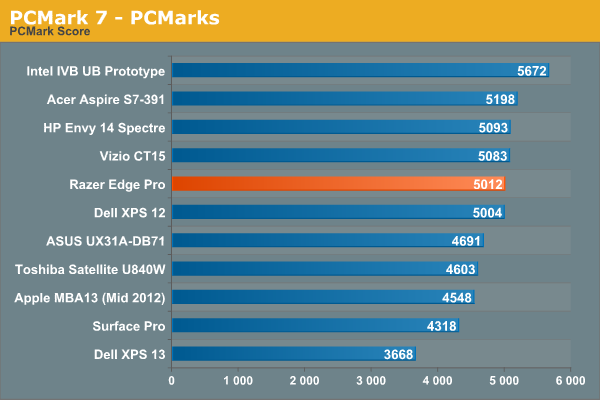
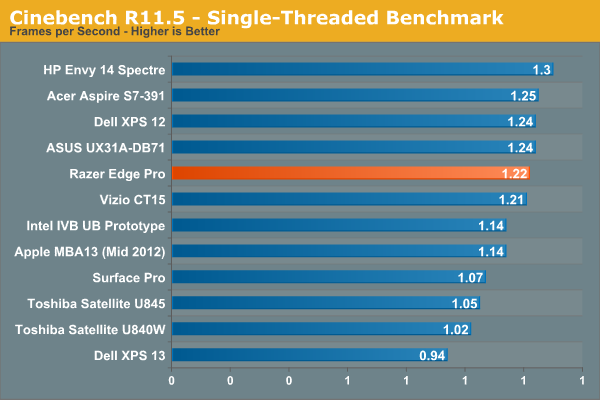
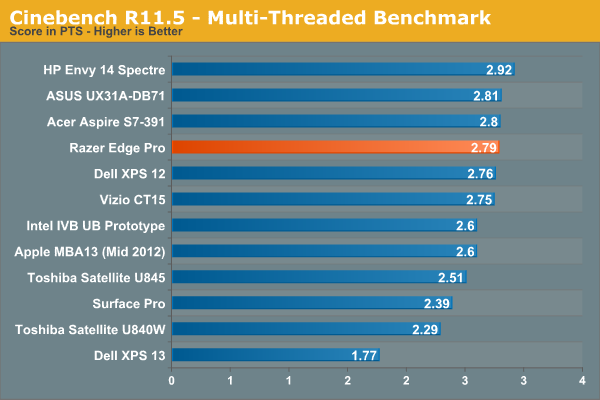
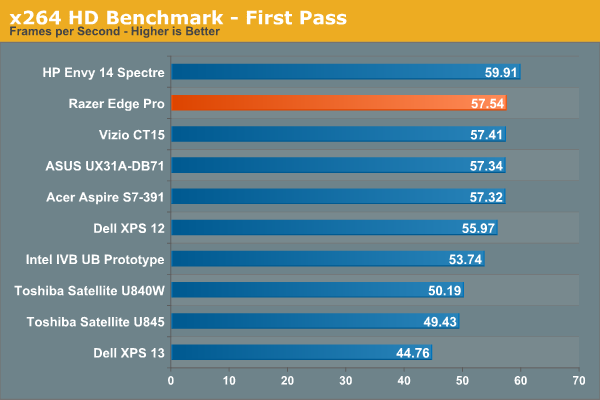
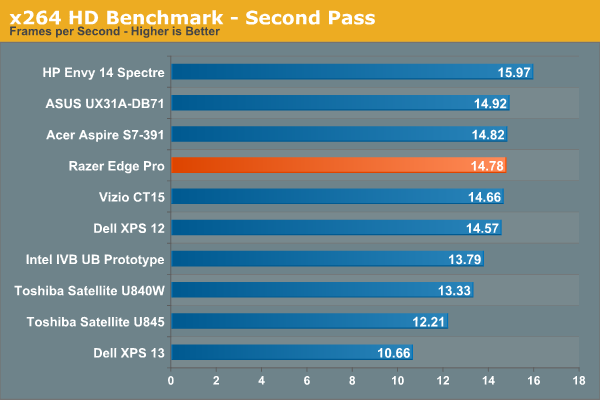

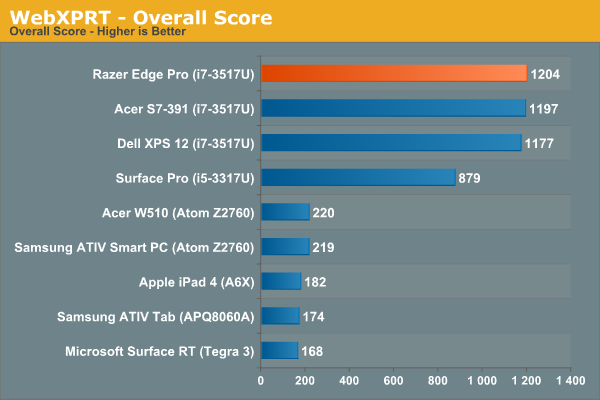
Graphics Performance
Nvidia’s mobile GPU heirarchy can get very, very convoluted, particularly at the low end, with a mix of new, old, and gap-bridging parts all under the same name. As such, there are many variants of GT 640M and GT 640M LE, with a mix of SKUs spanning the 28nm Kepler, 40nm Fermi, and 28nm die-shrunken Fermi cores. An interesting and related side-note: a few days ago, Anand asked the mobile team if we had seen any Kepler-based GT 630M notebooks. It took a bit of searching, but eventually it was determined that none of the GT 630M SKUs are actually Kepler based, only 28nm and 40nm variants of the Fermi core. When the lineups are so jumbled that even we can’t keep track of them, there’s something wrong. Why are some GT 640Ms so slow, while others are nearly equal to the DDR3 GT 650M? Why are there still 40nm GeForce 600M parts? I wish Nvidia could simplify and streamline their mobile GPU lineup, it’d make our lives easier as well as being a lot more transparent for consumers.
The GT 640M LE in the Edge is thankfully a Kepler part, so a 28nm GK107 core with 384 cores, 16 ROPs, and 32 TMUs, just like all Keplers from the GTX 660M on down. This is the absolute bottom of the range, so it has the slowest memory configuration (900MHz DDR3) and a 500MHz core clock, with boost up to 570MHz. The next big hardware jump comes with GDDR5 VRAM in the GT 650M, and a combination of clock speeds and GPU boost make up the differences between SKUs.
The 1366x768 panel comes into play here – Kepler, even at 500MHz, is more than capable of pushing 768p displays at high settings in modern games. High quality textures really start to tax the slower memory in the low-end Kepler cards as you increase resolution, so even with higher clock speeds, 1080p gaming will be non-ideal at best and downright bad at worst. Don’t expect much to be playable, as even the DDR3 variant of the GT 650M basically failed the 1080p portion of our gaming tests. The GDDR5 GT 650M and the GTX 660M (which comes in GDDR5 form only) do better here, but there’s a pretty substantial gap between those two chips and the rest of the GK107 mobile parts at 1080p.
We haven’t yet finalized our 2013 Gaming test suite, so I just ran our 2012 test suite. I did almost all of my testing on the road, sans access to 1080p displays, so I only have 1366x768 gaming results (that’s our value gaming suite, which runs medium detail settings at 768p). I also ran at high detail settings, to see what kind of differences there would be. Once our new suite is finalized, I’ll update with results at 1600x900 and 1080p.


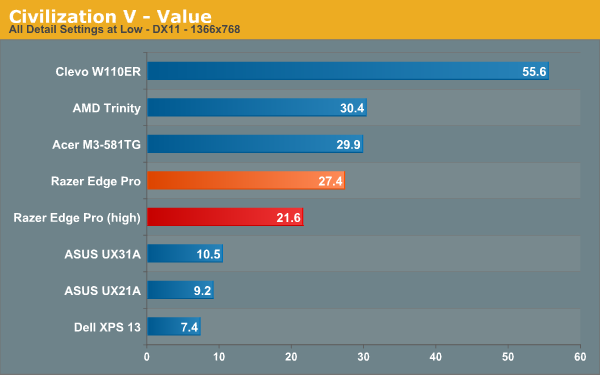
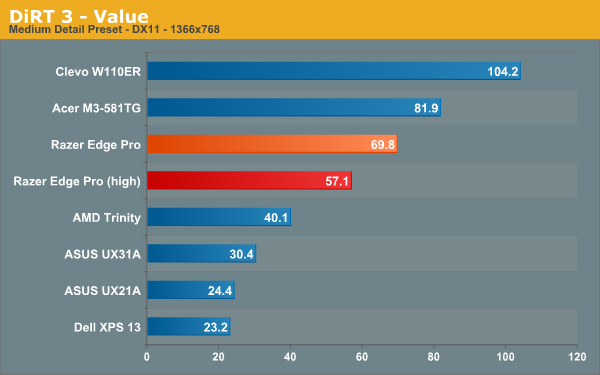
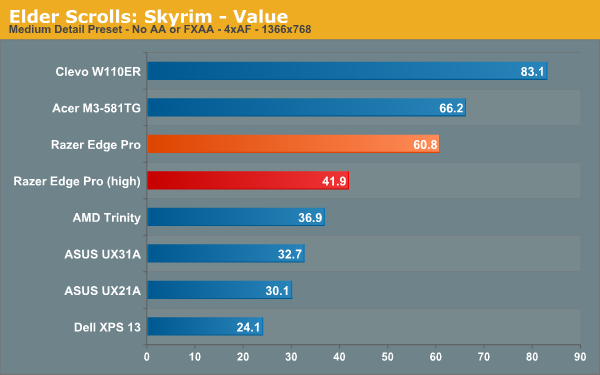
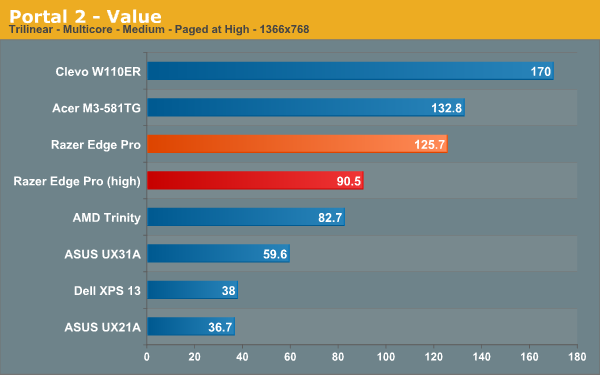
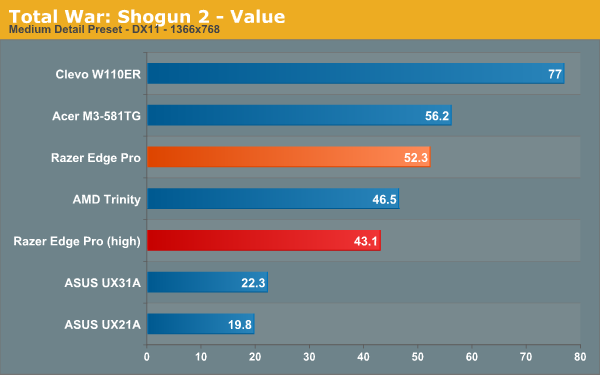
The Edge does pretty well, honestly – Kepler is a great mobile GPU, even clocked so low. At high settings, almost everything was playable, except for Battlefield 3 and Civ 5. I think Civ 5 is CPU limited on the Edge, while BF3 is one of the more strenuous games we test, so both of those were expected. Lower the settings to medium, and pretty much everything is playable.
The higher clock speeds of the GT 650M (DDR3) in the Clevo W110ER really make themselves felt, with substantially better gaming performance than the Edge throughout our benchmark suite. For a comparison with Surface Pro and the other IVB tablets, look at the ASUS Zenbook Primes - the UX31A with the 1.15GHz HD 4000 (i7-3517U) and the UX21A with the same HD 4000 clocked at 1.05GHz (i5-3317U). There's a small performance delta between the two due to the maximum frequency difference, but either way, HD 4000 seriously struggles to be playable in most of our benchmarks unless you lower either the resolution or detail settings. Again, Kepler at 500MHz is still a pretty capable card at 1366x768, so concern over frame rates is probably a moot one unless you’re gaming on an external display.










89 Comments
View All Comments
randomlinh - Thursday, March 28, 2013 - link
This is how I envision a Steam box. Pick up and play anywhere... and if I have the time, dock it to a TV for big screen fun.Now I just need the price to cut in half....
SR81 - Thursday, March 28, 2013 - link
... except Valve has the intention of it being a $99 set top box that streams your games from your PC, just like the NVIDIA Shield without a screen.Mumrik - Thursday, March 28, 2013 - link
I have to assume this thing is for people looking to replace their normal stationary/laptop.Havor - Friday, March 29, 2013 - link
Yeah still, but for a starting price of $999, this is actually NOT pretty good value.Come on $1000 for a heavy tablet, with only a 64GB SSD ware a big chunk will be used by the Win8 OS, and then $250 for the gaming grip.
Even the Razor Edge Pro with a 128GB SSD and a i7 instead of a i5 would be at $1000 to high to be useful!
Not saying that the price is to high for what it cost to make the tablet, I say the price is way to high for the real world value of the tablet, think whit a efficient Haswell CPU they could make something lighter and more useful.
But unless they get the price down to around $500~600 with a included game controller grip, i dont see lots of people buying this overpriced tablet.
And I wonder if the reviewer was smoking pot, or is this is a Infomercial, instead of a real review, because even do its a wonder of engineering, i don't see the appeal, and a product like this would only find buyers if it had the Apple logo on it!
perry1mm - Saturday, March 30, 2013 - link
I don't understand how you can say this is not good value. $1000 is not much if you're in the market for a laptop/tablet and are on the go enough to make it worth it...plugging in and playing games in a small profile for easy packing, carrying, and just general versatility, this is a dream come true.There are other options out there that I personally think are more feature rich and fit my personal use better in the same price-range and versatility, but even so the Edge fits the same type of device I'd want...and for comparable laptop performance you'd pay the same.
I wouldn't need anything but the keyboard dock if I did get one of these, though I personally have the Vaio Duo 11 that play games great and is much better out-of-the box feature-wise, port-wise, and display-wise. Plus I got the highest spec'd one with 256GB SSD for $1300 after a promo and $100 credit back with the Sony Card.
The main issue would be regular on-the-go battery life but if you can stretch it on power mode to get 4-6hrs, I think that is suitable, since anyone who is getting this should already expect to plug in for heavy game usage unless they're on a flight and want a couple hours of it.
If they packaged the keyboard dock when it is available with the Pro i7, 256GB, 8GB RAM model, for $1500, it would probably be one of the best value gaming laptops for portability on the market.
The Surface Pro with it's i5 and 4GB RAM is sorely lacking in performance. The only real downside for me is the resolution, as my Vaio Duo has spoiled me in that department and all the games I've played (DmC, HL2, Dota 2, WoW, Borderlands 2, Bastion, SC2, Portal 2, L4D2, FC2, and numerous others) all ran smoothly at 1080p if I turned down most settings and looked great at solid 30+FPS if not better.
Havor - Saturday, March 30, 2013 - link
" $1000 is not much"I am very well off, I am a supervisor in the offshore, and my wife is a deputy director of a local part of the national institute.
Still i think $1000 is way to mouths for what you get in return, like i said, not saying that the price is to high for what it cost to make a device like this, saying if you wait 1~2 generations, you get way more for a lot less.
This tablet falls in the category as the first LCD TVs, they ware around $5000 for a 40", and just like this tablet, the asking price was not to high for what it cost to make one, I am saying, you have to be a idiot to pay $1000~$1500 for something that will be outdated in 2 years by way better devices.
"for $1500, it would probably be one of the best value gaming laptops for portability on the market."
Got a ASUS G75VX for work, and a Transformer for on the road, ware i depending on use use the dock with, nut yeah i cant play FPS games on the Transformer, still there are lots of other fun games other the Angry Birds that i can also play on it.
The G75 is a real desktop replacement, i can use when i am @work, I am "on the go enough" about +50% of the year, but i cant really see any real benefits over a normal tablet.
"The Surface Pro with it's i5 and 4GB RAM is sorely lacking in performance."
I never said the Surface Pro was a good deal, I say your a idiot or have to mouth money if you if you buy this, as you can be a early adopter of tech that is not ready for prime time, if you buy it anyway i and many others will think something of you, if you tell the total price of what you got in your hands.
"you must be the one smoking pot if you think this would be $500-600 with a controller grip"
Read correctly, i did not say the device was was overprices for the tech you get, i say the its just not worth it, as in 2 years from now you get the same for half the price and weight, whit 50% more powerk
rviswas11 - Tuesday, April 2, 2013 - link
i don't think you realise that the only in this thing that is going to get outdated in the next 2-3 years is the battery. as far as the performance goes even you anus will be outdated in the same time framerviswas11 - Tuesday, April 2, 2013 - link
sorry i ;meant asus.truthbeacon - Saturday, April 6, 2013 - link
Again, it still depends on your perspective - As a consultant in a field where I am working the same places as you (and at the slope among other places which are out of touch with the world) and I never go anywhere without my $1400 (two years ago) SB slate.What you are glossing over with regards to value is that even when flying at the front, it is infinitely easier to get more work done with a tablet or slate pc because they take up so much less space (even this chunk). If you throw in the ability to do a good job of playing games for those exceedingly rare occasions when you don't have reporting or bureaucratic nonsense to deal with, you don't want to have to pull out a 15" {even ultrabook although they suck for gaming compared to ones with discreet cards} to do anything.
Where the slate PCs come in at far handier than a tablet is that when I am leaving a site with a 6 hour flight to my next destination, I can pull out my slate and begin working on reports and generate graphs using the same proprietary software that I just collected data on. I am not limited to almost-office software, at the mercy of what is (or more appropriately what is not) available for my ARM-based device and can even bring along a full ergonomic keyboard if I wish. Further, when I am flying out, I can prepare my data collection software so that when I arrive I am not scrambling to meet the always over-optimistic "we're going to start up this afternoon" hopes, because you know how bad critical path is during a startup.
perry1mm - Saturday, March 30, 2013 - link
Oh, and to add with your last couple of comments...you must be the one smoking pot if you think this would be $500-600 with a controller grip. Are you f***ing serious, lol. That barely gets you an iPad, Surface RT, Nexus 10, or a laptop with s*** specs. To say it should be that price WITH the controller grip is absolutely asinine.And YOU don't see the appeal, but for someone like myself that travels regularly, is on-the-go for work almost everyday where I spend an hour or two sitting down in various locations, travel regularly for family, vaca, or just to get away with my wife for the weekend, it is perfect. The tablet versatility, performance when needed and I can plug in, plus the small profile for easy carrying/storing/space-use constraints, it really is awesome.